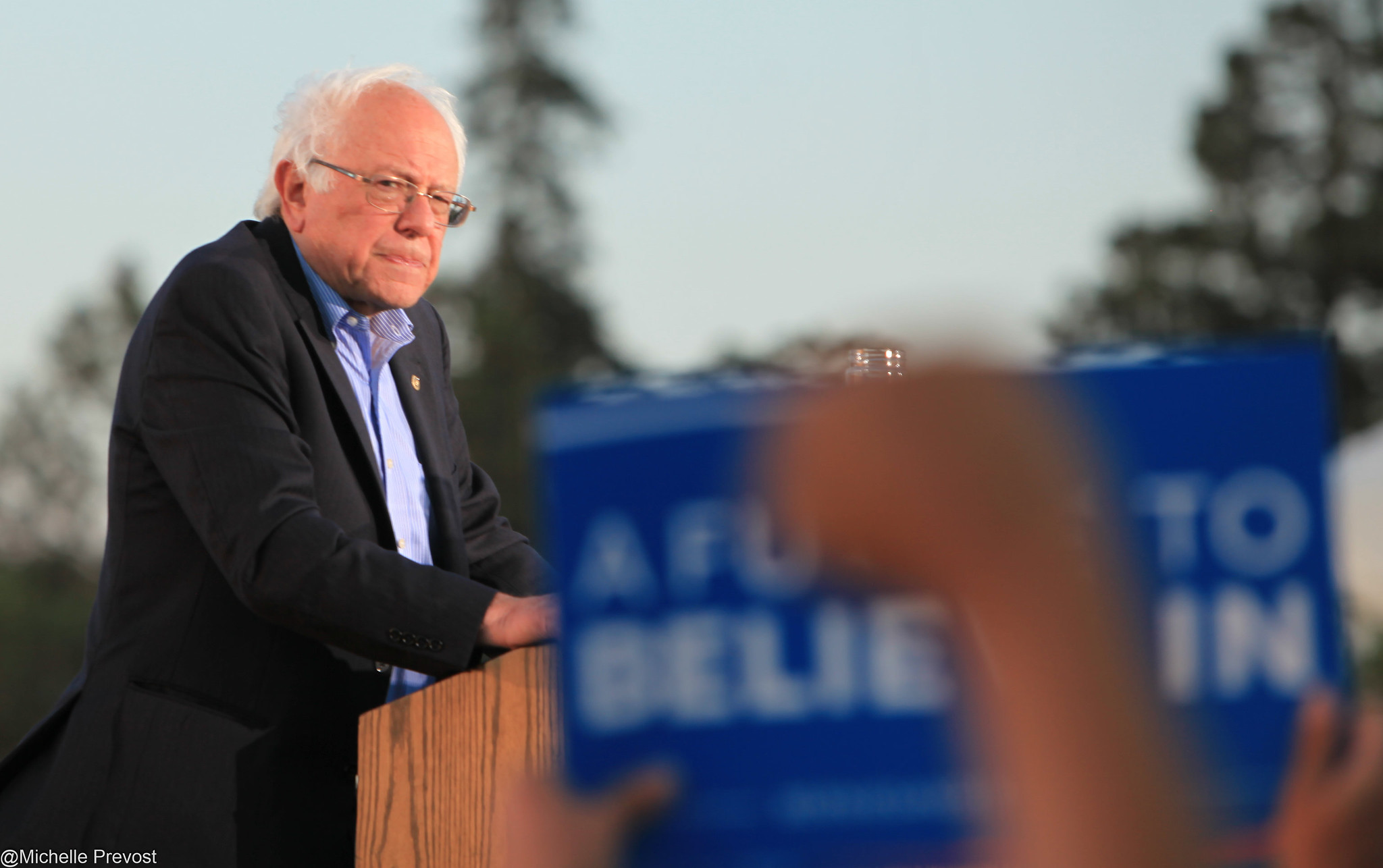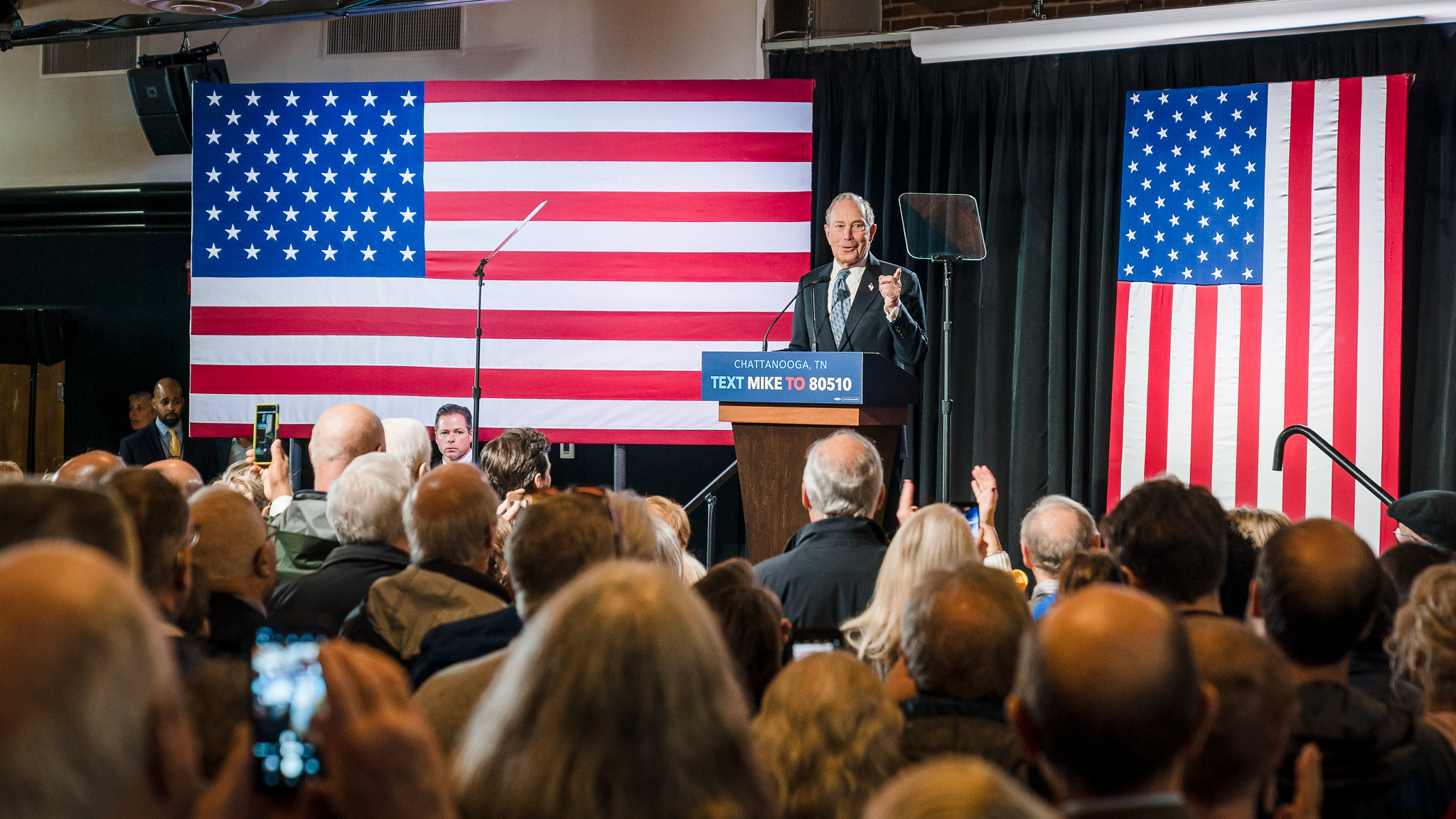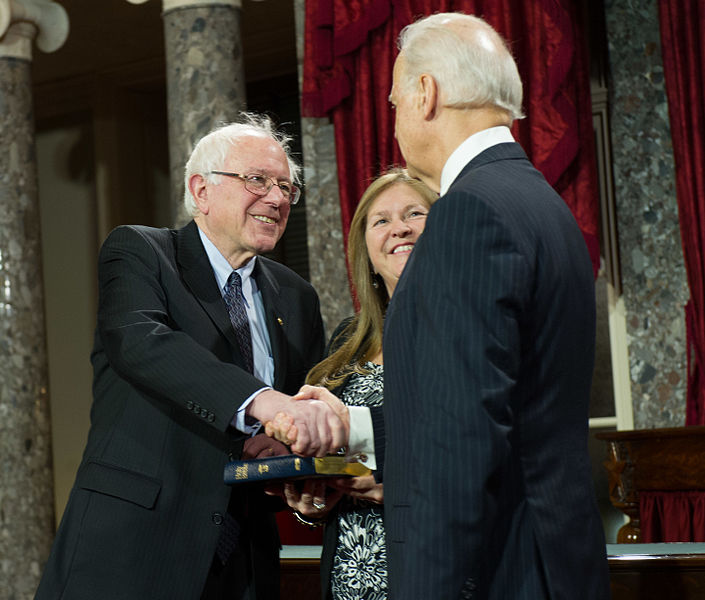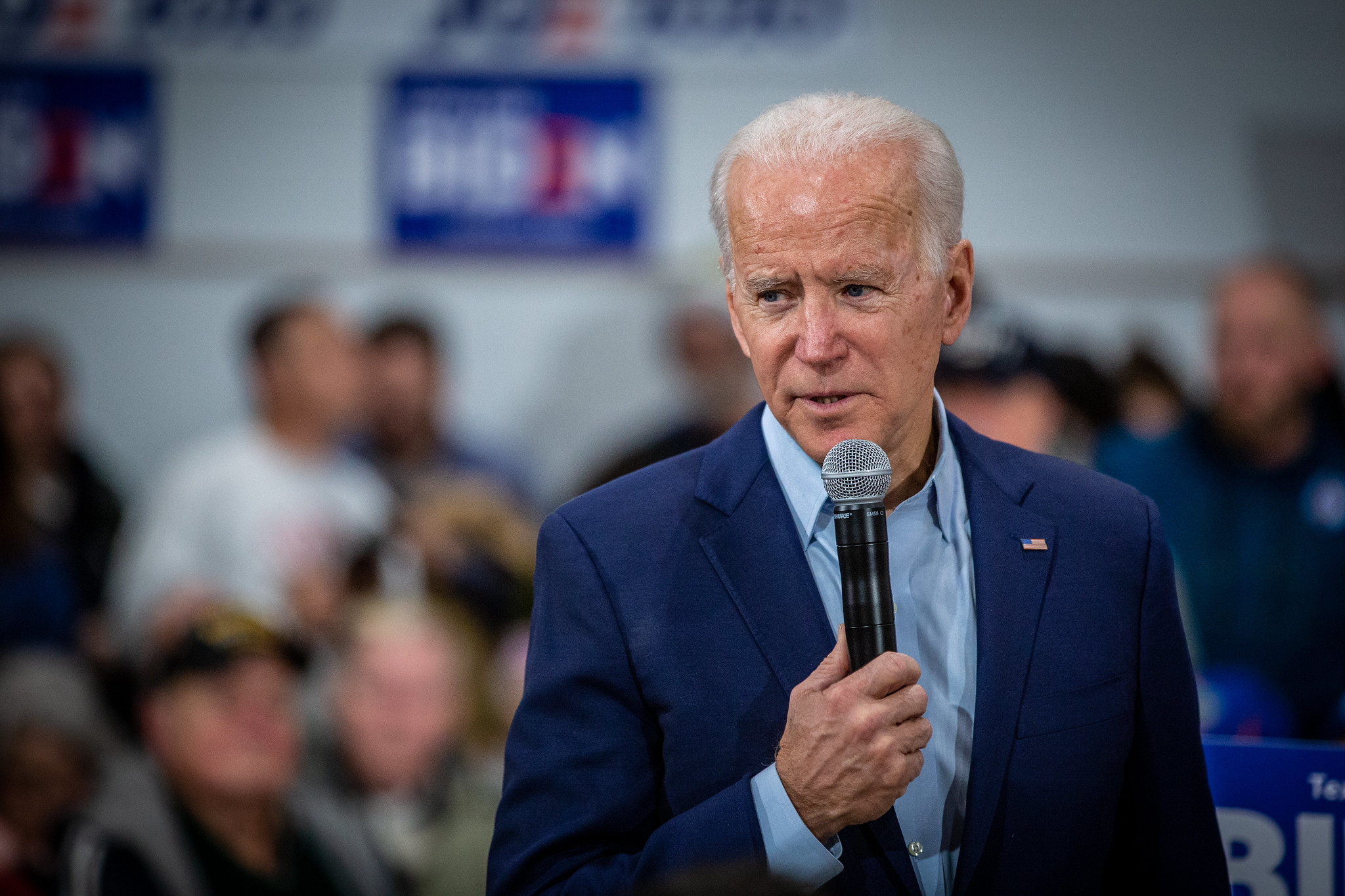The outcome of Super Tuesday (in which the largest number of delegates in a single day of the US Democratic primary race are up for grabs) has been gleefully celebrated in the bourgeois media. They see Joe Biden’s “comeback” as the best way to put an end to Bernie Sanders' momentum, which is seen as a major threat to market stability.
Last week, CNN host Michael Smerconish inadvertently blurted out what many capitalist strategists were asking themselves: “Can either Bernie Sanders or the Coronavirus be stopped?” Following the results in South Carolina, the desperate panic of the commentators was turned into a feverish drumbeat about Biden’s growing momentum. The New York Times headline read: “Biden Wins South Carolina as Race Against Sanders Intensifies.” It would appear that beating Sanders—rather than beating Trump—is what’s really at stake for the Democrats!
All of this political instability reflects the economic and social instability of American capitalism. This was seen in 2016 and it is being expressed again by this year’s Sanders campaign. A self-described “democratic socialist” who says his election would bring a “political revolution” is running in one of the main parties of the class enemy—the capitalist Democratic Party. Prior to 2016, none of the main bourgeois commentators would have predicted the growth of interest in socialism or the popularity of Bernie’s campaign. This is unquestionably of tremendous symptomatic importance.
However, the Sanders campaign, both in 2016 and in 2020 has been based on three false political assumptions:
- A self-identified socialist can enter one of the two main capitalist parties and gain its nomination for president of the United States.
- A socialist candidate can buy into the logic of lesser-evil politics and not be strangled by the very same logic.
- That socialists can find a short cut—and actually contemplate winning the presidency of the United States—without first building a mass working class party with a basis in the unions and winning a series of other local, state, and national offices.
Although the nominating contest is not yet over, the noose is closing in on Sanders. We believe that serious socialists and communists involved in the Sanders campaign should use the post-Super Tuesday moment to draw a balance sheet of the Sanders experience so far in the light of the above false assumptions.
After Nevada: the Democrats strike back
The Iowa debacle underlined just how low the Democratic Party leadership is willing to go to cut across Bernie’s momentum—and the disdain they have for his supporters. Any remaining illusions in the Democrats should have been burned away by the booing Sanders received in the South Carolina debate on February 25. The debate hall was stuffed with Democratic Party bigwigs who paid $1,750 to $3,200 for prime seats. Other tickets were “only $28.50 per seat”—which would require a minimum wage worker to work at least four hours to buy a ticket. We can be sure that few minimum-wage workers were in the hall!
 The Iowa debacle underlined just how low the Democratic Party leadership is willing to go to cut across Bernie’s momentum—and the disdain they have for his supporters / Image: Flickr, Shelly Prevost
The Iowa debacle underlined just how low the Democratic Party leadership is willing to go to cut across Bernie’s momentum—and the disdain they have for his supporters / Image: Flickr, Shelly Prevost
The Democratic Party establishment was getting extremely nervous that Bernie might actually beat the odds of their rotten game and end up with the majority of delegates needed to win the party’s nomination outright. In addition to majority support in Iowa and New Hampshire, Bernie had just won a convincing victory in Nevada, with almost 47% of the vote. The machinery of the DNC set into motion a concerted offensive against Bernie, hoping to stop his momentum in South Carolina, a Southern state of five million people and traditionally quite conservative.
Both the Democrats and Trump moved to limit the parameters of the debate in order to hobble Sanders and bring him under their control, hoping to get him to dance on a string like a marionette. They brought up the issue of the Cuban Revolution and positive comments he had made in the past about Fidel Castro. This, they asserted, would “take Florida off the map”—a reference to that important swing state’s hefty share of electors to the Electoral College. This was a scare tactic to plant the seed in people’s minds that Sanders was “unelectable” and would pave the way for Trump’s reelection. Needless to say, they never mentioned that Cuba had been an impoverished brothel for American big business prior to the revolution!
They also brought up Sanders’s past support for the Nicaraguan Revolution—never mentioning the US government’s support for the Somoza family’s bloody dictatorship and the subsequent counterrevolution of the murderous Contras, coordinated by the CIA.
And when Donald Trump said that he expected to face Biden or Sanders in November, he added: “Everyone knows he’s [Biden] not a communist . . . with Bernie, there’s a real question about that.”
As dramatically as consciousness has been transformed over the last few years, the US is still a generally conservative country, and especially older voters—who dominate most primaries and caucuses—can be spooked into lesser-evilism through comments and pressure like this. To his credit, Sanders did not back down on Cuba and Nicaragua, which certainly makes the ruling class uncomfortable. He did, however, fall into their trap and felt compelled to say, “Obviously I am not a communist,” adding that Trump “maybe doesn’t know the difference.”
The establishment unites
Given this situation, the Democrats circled the wagons against Bernie. In South Carolina, Joe Biden did indeed win the primary by a hefty margin. But the way the media covered this exposes their not-so-hidden agenda. In 2016, Bernie Sanders was crushed in South Carolina by 47 points and he received just 96,500 votes. This time, Sanders lost by just 28 points and his total vote was over 105,000, actually gaining votes, although there were many other candidates. Warren received more than 37,000 votes, many whom would have voted for Sanders if she were no longer in the race. And Biden received fewer votes than Clinton did in 2016, despite this year’s larger turnout. Unsurprisingly, the mainstream media did not point any of this out. Instead, they carried the establishment message that “Biden is back!” to help build his momentum going into Super Tuesday.
Immediately after South Carolina, billionaire Tom Steyer dropped out of the race. Then, Mayor Pete Buttigieg “met with former President Jimmy Carter.” Next thing you know, Mayor Pete was out and had endorsed Biden. Then Amy Klobuchar of Minnesota, an important Super Tuesday state, ended her campaign and promptly endorsed Biden. Beto O’Rourke also endorsed Biden in the crucial state of Texas, another Super Tuesday state. Other establishment Democrats like Harry Reid and Terry McAuliffe also publicly endorsed Biden. The ruling class is clearly cracking the whip. If anyone wants a job, contract, or access to a future Democratic Administration—they’d better get on the Biden train. As for former President Obama, he has held off on publicly endorsing Biden so as to use his sway later on to numb the pain of yet another bait-and-switch as millions of Sanders supporters are told they have no alternative but to vote for Biden.
Elizabeth Warren has played a particularly savvy role for the establishment. She has now announced that she is suspending her campaign. But as long as she stayed in the race, she took more votes from Bernie than from Biden. She also helped derail the Bloomberg hype train in two debates, which objectively helped Biden.
What happened on Super Tuesday?
James Carville, the political consultant who has accumulated lots of wealth through politics, gave the Democrats their marching orders. He said that the goal was to keep Bernie Sanders below 1,991 delegates. This is the threshold needed to win the nomination on the first ballot at the party’s national convention. There are a total of 3,979 delegates up for grabs, and going into Super Tuesday, Bernie had 60, while the motley crew of “moderates” had 95.
This meant that, prior to Super Tuesday, Sanders would have to win at least 50.5% of all of the remaining delegates to secure a majority. Biden only needs to stop Bernie from getting to 1,991 as he is all-but-guaranteed to get the delegate votes from the other candidates. And if nobody clears the magic margin on the first ballot, the 771 superdelegates—most of whom are vehemently against Sanders—would be added to the second round of voting. It’s not difficult to guess how this is all likely to go down.
 Bloomberg’s deep pockets may now be used to help the former Vice President to win the primaries and put an end to Sanders’s attempt to reform the Democratic Party / Image: Flickr, Mike Bloomberg
Bloomberg’s deep pockets may now be used to help the former Vice President to win the primaries and put an end to Sanders’s attempt to reform the Democratic Party / Image: Flickr, Mike Bloomberg
As for the Democrats’ potential trump card, Michael Bloomberg, although he bet hundreds of millions from his personal fortune on Super Tuesday, he fell flat on his face, damaged beyond repair by his racist past and pathetic debate showings. After headlines such as “Bloomberg did not have a Super Tuesday,” he dropped out of the race like a stone. This further clears the way for Biden, and Bloomberg’s deep pockets may now be used to help the former Vice President put an end to Sanders’s attempt to reform the Democratic Party.
As per the preliminary results from the elections on Super Tuesday, it seems clear that the media campaign against Bernie, the coalescing of the “moderates” around Biden, and Warren’s continued campaign worked, and that Biden won more delegates than Sanders. In order to get to 1,991 delegates, Sanders would now need to win even more than 50.5% of the remaining delegates, and this is highly unlikely, especially with the complex algebra of the party rules. Sanders would have to do incredibly well in most of the remaining states to win. The bourgeois media and Democratic Party machine weigh heavily in states such as New York and New Jersey—not to mention the powerful labor unions and black churches, whose leaders will go all-out for the establishment favorite: Biden.
Sanders may yet pull off the upset, but his path to the nomination is now extremely complicated. And we all know that even if Bernie won the nomination and the presidency, most elected Democrats would strongly oppose his reforms, setting him up for a government of crisis.
Lessons from the Sanders campaign and the way forward for socialists
As we outlined at the beginning, there were many false assumptions behind Bernie’s strategy. Some socialists saw running on the Democratic Party line as a shortcut to victory. They bought into these illusions because of how well Sanders did in the 2016 primaries and caucuses, forgetting that some of that was simply part of the widespread “never Hillary” sentiment.
 The logic of lesser-evilism will be then turned against Sanders himself. “If a more ‘moderate’ candidate has a better chance to win the election, then we must support Biden!” / Image: US Senate
The logic of lesser-evilism will be then turned against Sanders himself. “If a more ‘moderate’ candidate has a better chance to win the election, then we must support Biden!” / Image: US Senate
By running as a Democrat, Bernie entrusted his fate to the party electorate—not the broader population. Some of those voters are working class, but not all, and not all workers are conscious of their class position in society and the true nature of the Democratic Party. Most of those who participate in the party primaries and caucuses tend to be those with illusions in the party in the first place.
A candidate who runs as a Democrat also gets sucked into the quagmire of “lesser evil politics”—instead of class politics. They blame Trump’s policies for the problems they face—instead of connecting these problems to the capitalist system.
The logic of lesser-evilism is then turned against Sanders himself. “If Trump is the source of the problems, we must get rid of him at any cost! A more “moderate” candidate will surely have a better chance to win the election. Therefore, we must support Biden!” This is the logic that led to Trump’s election in the first place—and it may well lead to his reelection in 2020.
A genuine socialist campaign would expose the contradictions of the system and the role that both Democrats and Republicans play in this. Neither of these parties can solve the problems facing the working class—that must be our message. The vast majority of Americans instinctively realize this. Even if many don’t agree with us now, experience will bring them towards us if we stick to our guns and continue our patient explanations.
The decline of US capitalism, especially since 2008, has led to a huge increase in interest and support for radical ideas, but the movement is still in its early stage. It is not realistic for a movement that is just beginning to think it can come from nothing and then elect a President, not to mention the many contradictions of bourgeois democracy. Unfortunately, winning socialism will not be as simple as voting for a candidate who promises a few reforms—and certainly not one running in a capitalist party. People who really want a socialist future must build a solid foundation now and avoid the false temptation of a shortcut to victory. These are harsh words and a harsh reality, but a reality check is what is needed in times like these.
Where do we go now?
All serious socialists must examine the situation and draw the necessary conclusions. Marxist theory is the generalization of the lessons from past struggles of the working class. It allows us to withstand the hurricane winds of capitalist pressure and propaganda. The most important step forward is to build the infrastructure for the future.
As we explained in our 2014 document Perspectives for the US Revolution: “[We] must begin with the painstaking work of building a cadre organization that can transform its accumulated quality into numerical quantity on the basis of future events. We cannot allow ourselves to be confused in any way with the reformists of any stripe. We cannot blur the lines between a reformist and a revolutionary policy. We must, at all times, present a clear banner that differentiates us and serves as a point of reference for the future. Otherwise, the workers will not learn from the experience and will not know who to turn to when events bear out our perspectives.”
This was written long before the Sanders phenomena, the rise of DSA, and Trump’s election, demonstrating the superiority of Marxist perspectives over the astonishment of the bourgeois and petty bourgeois. What is required is a solid cadre organization—a nationwide network of skilled revolutionary activists, trained in Marxist theory and agitation, and capable of spreading a program for the socialist transformation of society among broad layers of the working class.
Once this foundation is built, socialists could run independent candidates in congressional, state legislative, and city council districts with big working-class concentrations. Many of these districts are solidly under the control of either the Democrats or Republicans. Running an independent socialist candidate would actually give people a choice in the election. Even more important than winning, these campaigns would offer socialists a platform to explain our program and ideas to broad layers of the class.
This strategy is not a get rich quick scheme, but it is the only way forward. Those who insisted that the Democrats could be taken over or that socialists could build a wing within this party and later attempt a “dirty break” look especially foolish after the results of Super Tuesday. If Sanders is sidelined and Biden is the nominee, how will this build a “socialist wing” of the Democratic Party? The working class is the vast majority of society and it has tremendous potential power once it becomes conscious of it—including the power to build a mass party of our own.
Many workers and youth have drawn conclusions that the Democratic Party is not their party and do not want to vote in its primaries. To the extent that they vote for Bernie, it is in spite of his running as a Democrat, not because of it. Those who argue for running in the Democratic Party are trying to bring these people into this party and this is a step backward. It has also not met with much success. In the primaries and caucuses held so far, voters under 30 years old have made up less than 20% of the electorate and in most of the states just 15%.
Many Sanders supporters will be dejected and disappointed by Super Tuesday’s results—and keenly aware of how their preferred candidate has been treated by “his own party.” With clear evidence of voter suppression and other “irregularities,” it is no surprise that the hashtags #RiggedPrimary and #RiggedDNC are trending on Twitter.
Those who really want to transform society must look deeply at the tasks facing socialists and what must be done to prepare the ground for a mass socialist party and a workers’ government in the next historical period. We have no time to waste to begin building for a socialist future. This is what the IMT is all about and we invite you to join us!

